|
~~~~~~~~~~~~~~~~~~~~~~~~~~~~~~~~~~~~~~~~~~~~~~~~
Mrs. Morphy is renowned in the
salons of New Orleans as a brilliant pianiste and musician; and her son, without
ever having studied music, has a similar aptitude for it, and he believes he
would have become as famous therein as in chess, had he given his attention to
it.
~Paul Morphy, Chess Champion by an Englishman (F. M. Edge)
p. 138
~~~~~~~~~~~~~~~~~~~~~~~~~~~~~~~~~~~~~~~~~~~~~~~~
Paul Morphy was raised in a musical
arena. His mother, Thelcide Le Carpentier Morphy, was a superlative musician
whose home was a Mecca for visiting notables of the music world as well as a
meeting place for the talent musicians of New Orleans.
Thelcide's granddaughter, Regina
Morphy-Voitier, in her late-life pamphlet on Morphy, wrote rather
matter-of-factly:
Almost every week,
Mrs. Morphy entertained large house parties, and her weekly "musicales" were
highly artistic and
enjoyable. Although Paul was not a musician in the true sense of the word, he
was noted for his splendid ear for music, and
once he heard a tune, he never forgot it, and he thoroughly enjoyed these
evenings devoted to classic music and brilliant
conversation. (p. 28)
Mrs. Morphy very often
contributed to the enjoyment of these gatherings by her talent, possessing a
magnificent voice. She
was noted as a composer, having composed many delightful trios for piano,
violin and 'cello. (p.37)
One of Mrs.
Morphy's piano students, as well as a close family friend, Léona Queyrouze,
painted a much more intricate picture in her unpublished manuscript, the
First and Last Days of Paul Morphy:
There were about forty-five music-stands at hand, in a closet adjoining the
music-hall; and on the grand concerto-days, they were all taken out and grouped
around the splendid Erard, which had been manufactured especially for Mrs.
Morphy and transported to her Louisiana home, with more solicitude than if it
had been a priceless jewel. It was exceedingly simple in appearance, and
destitute of a single ornament. It's value consisted entirely in it's wealth of
sound, and resided within the
plain rosewood frame, for the harmonies which issued from it were powerful and
thrilling.
There was a large and high music-hall in the house, so
constructed as to be intensely sonorous, and it had been fitted up in a way that
favored the reverberation of sound, which was not muffled and stifled by the
thick carpets; heavy draperies and encumbering furniture. Besides the piano, it
contained numerous light chairs, and a few massive music-stands of antiquated
style. There was also a vast rosewood book-case, filled with all the
master-pieces of classical music. When Herg, Thalberg and other celebrated
artists came to New-Orleans, it was there only that they found various works
which they had been unable to procure elsewhere in that city.
All kinds of musical instruments stood up against the
walls, or hung upon them in panophiles. Some of them were scattered pell-mell on
the chairs. Many years later, after Paul Morphy had become the king of
chess-players, several very fine engravings found their way into that room; and
in some of them he was seen playing with some famous champion. When he returned
from his first visit to Paris, he brought back to his mother a copy of his bust
- by the great sculptor Lequesne. It was proudly placed by her in her sanctum.
That copy, smaller than the original bust, also came from the hands of Lequesne
who presented it to Mr. Morphy, as a token of friendship and admiration.
On one side of the hall was the broad back-gallery,
protected from the sun's heat by the dense umbrage of the trees; and on the
other, the oval-shaped vestibule, through the lofty glass-dome of which the
light poured in, illuminating the music-hall
and showering aureoles upon the marble busts of Hayden, Mozart, Beethoven,
Weber and Mendelssohn, the divinities of that temple. Here and there, the
reflection of a golden beam was caught by one of the quaint old copper
music-stands, shaped in the form of a lyre, or lingered on some brass instrument
glittering in an obscure corner. At certain hours the room was all constellated
with stray sparks of sun. At night, the stars glowing in the luminous sky, and
the moon's tranquil rays, falling from the transparent dome and vaguely
whitening the darkness, imparted a weird aspect to the vestibule,
full of dusk and silence.
People, apparently,
were astonished by Morphy's ability to reproduce even the complicated score from
an opera after hearing it only once:
I asked his if his
nephew was remarkable for anything else than his peculiar aptitude for chess,
and I recollect that he stated,
among other things, that after his return from a strange opera he could hum or
whistle it from beginning to end.
~Dr. L. P. Meredith’s Letter in the Cincinnati Commercial - New
Orleans April 16, 1879
Almost every week, Mrs. Morphy
entertained large house parties, and her weekly "musicales" were highly
artistic and
enjoyable. Although Paul was not a musician in the true sense of the word, he
was noted for his splendid ear for music, and
once he heard a tune, he never forgot it, and he thoroughly enjoyed these
evenings devoted to classic music and brilliant
conversation.
~Life of Paul Morphy in the Vieux Carré of New Orleans and Abroad; p. 28
Morphy, after leaving the
theatre, hummed over many airs to me, which he had just heard for the first
time, with astonishing precision.
~Paul Morphy, Chess Champion by an Englishman (F. M.
Edge) p. 138
He was passionately fond of
music, and his memory in regard to it, was as prodigious as for chess. After
having once heard
any opera whatever, he could sing or whistle it almost through, with the
greatest facility and accuracy.
~First and Last Days of Paul Morphy
Morphy's first love
was the opera, but he wasn't limited to that particular musical form. Léona
Queyrouze described a moving encounter she had with Paul as he surreptitiously
watched her play the piano:
He was a worshipper of Beethoven, Weber and Mendelssohn; and when his light,
nervous step, so familiar to me, resounded in the sonorous vestibule, at one
o'clock, the time at which he came in from his promenade, I often stopped
practicing, and set aside scales and exercises for some of his favorite adagios,
andantes or scherzos. The doors of the music hall were always open, and when he
passed by it, he looked in with a smile, nodded and went.
He was particularly fond of "La Bella Capricciosa" ,
one of Hummel's most exquisite gems [Polonaise for Piano in B
flat major, Op. 55 La Bella capricciosa by Johann Nepomuk Hummel].
Chopin's morbidness affected him painfully, and there were very few of the
Polish master's works which I ventured to perform for him. One day, I was alone
in the music-hall playing the "Berceuse" [a lullaby].
After a short while, I felt that somebody else must be present, but I did not
heed that impression, thinking that it could only be Mrs. Morphy or her
daughter. It grew more forcible every second, and at length I was irresistibly
impelled to turn around and look, before I had concluded that ideal composition.
Leaning against the black marble mantlepiece, under the large engraving which
represented him in one of his brilliant games with Louis Paulsen, both
surrounded by renowned amateurs, there stood Paul Morphy, silent and pale, with
tears trickling down his wan cheeks. I shall never forget that sight. Neither of
us spoke, and he immediately withdrew from my presence.
It was like an apparition.

Le Théâtre-Italien, Paris c.1850


The interior of the Théâtre-Italien
Inside a Box in the Théâtre-Italien
During Morphy's triumphal
tour of Europe, one of his most famous games, as most chess enthusiasts know,
was played against the Duke of Brunswick and Count Isouard in the Duke's box at
the Italian Opera House, and has been dubbed the
Opera Game. There is
often some confusion which opera was being performed during this game. The cause
of this confusion is that Edge describes Morphy playing these two noblemen in
their first encounter at the opera during which Norma by Vincenzo Bellini was
being performed:
H. R. H. the Duke
of Brunswick is a thorough devotee to Caïssa; we never saw him but the was
playing chess with someone or other. We were frequent visitors to his box at the
Italian Opera; he had got a chess-board even there, and played throughout the
performance. The Duke's box is right on the stage; so close, indeed, that you
might kiss the prima donna without any trouble. Morphy say with his back
to the stage, and the Duke and Count Isouard facing him. Now it must not be
supposed that he was comfortable. Decidedly other wise; for I have already state
that he is passionately fond of music, and, under the circumstances, wished
chess at Pluto. The game began and went on: his antagonists had heard Norma
so often that they could, probably, sing it through without prompting; they did
not even listen to most of it, but went on disputing each other as to their next
move. Then Madame Pencho, who represented the Druidical priestess, kept looking
towards the box, wondering what was the cause of the excitement inside; little
dreaming that Caïssa was the only Casta Diva the inmates cared about. And
those tremendous fellows, the "supes." who "did" the Druids, how they marched
down the stage, chaunting [sic] fire and bloodshed against
the Roman host, who, they appeared to think, were inside the Duke's box.
~Edge; pp. 154-155
However, as Edge
stated above, "We were frequent visitors to his box at the Italian
Opera." The Opera Game was played in one of their subsequent visits during
which Gioacchino Rossini's Il barbiere di Siviglia was performed.
On their first
visit in October they played chess throughout the entire performance of
Norma....
On the second of November they heard The Barber of Seville, during which Morphy
played his most famous game, the Duke again consulting with Count Isouard.
~Paul Morphy: The Pride and Sorrow of Chess by David
Lawson; pp. 159-160
Lawson's
assertion was affirmed via Edward Winter's Chess Note #2895 which reported that
"Christian Sánchez has consulted the fortnightly magazine L’Univers Musical
of October and November 1858. He reports that although Morphy’s name did not
appear, the 16 October and 1 November numbers mentioned that the October
performances at the Théâtre-Italien included
Norma, while the 15
November issue stated that
The Barber of Seville
had been performed that month. This schedule is in line with the information
quoted from Lawson’s book."
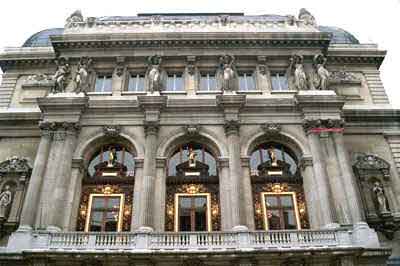
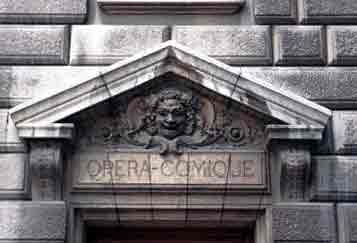
The Opéra Comique of Paris
In the
evening we went to the Opéra Comique, and witnessed a very unsatisfactory
performance of "La Part du Diable."
Morphy has a great love for music and his memory for any air he has once heard
us astonishing. Mrs. Morphy is renowned
in the salons of New Orleans as a brilliant pianiste and musician; and her son,
without ever having studied music, has a
similar aptitude for it, and he believes he would have become as famous therein
as in chess, had he given his attention to it.
"La Part du Diable" was a new opera, and Morphy, after leaving the theatre,
hummed over many airs to me, which he had
just heard for the first time, with astonishing precision.
~Paul Morphy, Chess Champion
by an Englishman (F. M. Edge)
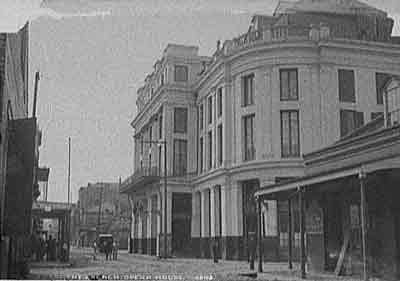
le Théâtre d'Opéra de la Nouvelle Orléans, 1880
Returning to New Orleans, Morphy
inserted himself into the routines of haute société which included regular
attendance at the le Théâtre d'Opéra, known more commonly as the French Opera
House located on the corner of Bourbon and Toulouse streets.
Paul Morphy was
exceedingly fond of grand opera and very seldom missed a performance at the old
French Opera House
on Bourbon Street, which was unfortunately destroyed by fire in 1920. During
intermissions, he would call upon some of his
lady friends who occupied boxes and invite them to a promenade in the "foyer"
where refreshments were served.
~Life of Paul Morphy in the Vieux Carré of New Orleans and
Abroad; p. 28
Since the new Opera
House was built in 1859, Morphy had, of course, attended the old opera house,
but after the erection of the new one, the old building was used for less
prominent productions and was soon torn down.
~~~~~~~~~~~~~~~~~~~~~~~~~~~~~~~~~~~~~~~~~~~~~~~~
A Concise
History of the French Opera House of New Orleans
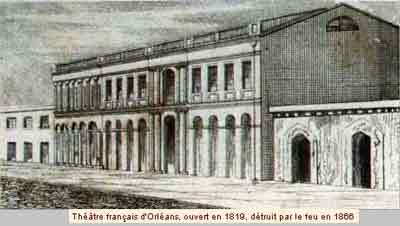
Le Théâtre d'Orléans 1819-1866

The first documented operatic performance in New Orleans, Silvain by Jean
François Marmontel, M. Grétry, took place on May 22, 1796. By 1809 there was an
actual opera season during which operas were regularly scheduled. A
building specifically for operas, le Théâtre d'Orléans, was constructed in
1815 by Louis Tabary (who came from Provence, France by way of Saint-Domingue
around 1805) but burned down the following year and was replaced in 1819 with
the building pictured above by John Davis, a New Orleans entrepreneur. Davis,
who came to New Orleans from France and as a refuge from Saint-Domingue,
had the property on Orleans Street (between Bourbon and Royal) locked-up with
control over the Davis Hotel, the Orleans Ballroom, and the Théâtre d'Orléans.
While the Théâtre d'Orléans catered to the Creole population, John Caldwell, an
Englishman in New Orleans, had built the Camp Street Théâtre mean to attract the
American population ("Americans" is a term often used to depict non-Creoles
living in New Orleans). As the two groups, Creoles and Americans, started to
homogenize, Caldwell and Davis became arch-rivals for the same dollars.
19th century New Orleans was highly susceptible to breakouts of
yellow fever. In 1819 alone there were
2,190 deaths from this
cause. To avoid this disease, as well as the heat and the possibility of cholera
and of hurricanes, many well-heeled families would leave the city during the
summer months. With this dwindled audience the opera cast originally disbanded
during the summer, but in 1826-27, Davis came up with the idea to mobilizing his
troupe and carry their talent to New York and Philadelphia where French drama
and opera were a rarity. Since New Orleans had a reputation for being the
premier operatic center in the U.S., the performances were quite welcomed.
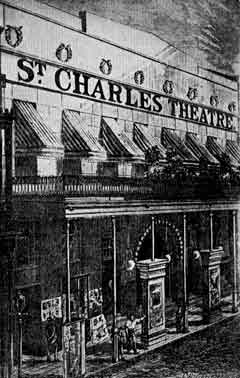
On November 30, 1835 John
Caldwell constructed a $325,000 behemoth with a 4100 seating capacity named the
St. Charles Théâtre (on St.Charles Street between Poydras and Gravier).
"Its front was 130 feet
wide, & the facade included a balustrade decorated with statues of Apollo & the
muses. Inside, the auditorium featured 4,000 seats, 47 boxes draped in crimson,
blue & yellow silk, and gilded columns flanking what was probably the largest
stage in the country -- ninety by ninety-five feet."
[see:
St. Charles Theatre]
It's most notable feature was "an enormous
chandelier 12 feet high & 30 feet in circumference of 23,000 crystal prisms
illuminated by 176 gas jets."
It's "productions were
popular and ran from the drama's classics of tragedy & comedy, to melodrama &
farces.... and to variety acts such as horse shows, acrobats, jugglers, singers
& comics." It also included opera, "importing Italian opera companies from
Havana, and further enriched the local repertoire by staging, again often for
the first time in this country, operas of Vincenzo Bellini (Norma, 1836),
Gaetano Donizetti (Parisina, 1837), and Rossini (Semiramide,
1837). [see:
New Orleans Opera]

In 1835 James Caldwell put on an
English production of Robert Le Diable by Giacomo Meyerbeer at the
St. Charles Théâtre. Shortly after John Davis staged a French performance of the
same opera at the Théâtre d'Orléans. Calwell's version received high critical
reviews and better acceptance from the audiences.
Unfortunately St. Charles Théâtre
burned down on March 13, 1842 when a fire in the adjacent coffin factory
spread to the theatre. However, even though the theatre was immediately
rebuilt, this event solidified the operatic prominence of the Théâtre d'Orléans.
Davis soon took on a partner,
Charles Boudousquié.
In 1840 M.
Charles Boudousquié, who subsequently became the husband of the fascinating
Calvé, recruited in France the first important company of singers to visit New
Orleans. They arrived on the ship "Le Vaillant," after a voyage of sixty days,
and less than a week later made their appearance at the Theatre d'Orleans in
Adams' "Le Chalet," Lecourt, tenor, and Victor, baritone, appearing in the cast.
Boudousquié continued to direct the operatic performances at the Orleans till
1859. During that interval many important works were produced, among them
"Robert le Diable," in 1840; "William Tell," in 1846; "La Juive," in 1847;
"Jerusalem," p729"Lucie de Lammermoor," and "Le Prophete," in 1850; and "Les
Huguenots," in 1853.
[see:
Kendall's History of New Orleans; Ch. 45]
By 1853 Boudousquié
had almost autonomous control.
In 1859 the Theatre d'Orleans was sold to a Mr. Parlange. Boudousquié proposed
to continue the lease of the premises, but not being able to accept Mr.
Parlange's terms, announced his intention of abandoning the house. Mainly
through his exertions the French Opera House Association was incorporated March
4, 1859, with capital stock of $100,000, divided into 200 shares of $500 each.
Boudousquié himself was largely interested in the company. Rivière Gardère was
chosen president, and the first board of directors was composed of George
Urquhart, E. J. McCall, Charles Kock, Gustave Miltenberger, E. Roman, C.
Fellows, Charles Roman, Leon Queyrouze and Adolphe Schreiber. A site was
purchased at the corner of Bourbon and Toulouse streets, and the erection of the
present building was begun on April 9, 1859. The architect was James Gallier,
and the builders were Gallier & Esterbrook. The work was prosecuted by day and
by night, 150 men being kept constantly on duty. The building was completed
November 28, 1859, at a cost of $118,500.
In the meantime Boudousquié had, by a contract dated April 12,
1859, undertaken the lease of the new theater. He
associated with himself the veteran manager, John Davis. The opera house was
formally opened December 1, 1859 with
"Guillaume Tell." The principal singers were Mathieu, first tenor; Escarlate,
tenor of grand opera; Petit, third tenor;
Melchisadek, baritone; Genibrel, first basso; Vauliar, second basso; Mme. St.
Urbain, second falcon. Later during the
season "Le Trouvère" and "La Fille duº Regiment" were produced, and "La Tour de
Nesle," "La Dame Aux Camelias," and
other French plays were acted, in accordance with a tradition of which the opera
had not yet been able to shake itself free.
The season of 1860 was likewise successful. The same singers
appeared, with the exception that Mme. Brochard replaced Mme. St. Urbain,
falcon. On November 8, 1860, the opening night, "Le Barbier de Seville" was
presented with Mme. Faure in the role of Rosine. Among the operas which were
presented during this season were "La Favorite," "Il Trovatore," "La Juive" and
"Robert le Diable." Early in 1861 Adelina Patti made her first appearance at the
French Opera House, as Martha, in Flotow's opera of that name. During her
engagement Patti sang also in "Les Huguenots," "Robert le Diable," "Charles VI,"
and "Lucie." In 1862, 1863 and 1864, on account of the Civil war, there were no
performances at the Opera House.
In January, 1866, an Italian troupe, under the direction of Thioni
and Susini, gave a few performances. Paul Alhaiza then became director of the
opera. He recruited in France a very large and capable troupe, but the entire
membership was lost at sea, October 3, 1866, in the wreck of the steamer
"Evening Star." Of the 250 souls on board this ill-fated vessel, only
seven escaped. Among those who were lost were Gallier, architect of the opera
house, his wife and Mr. and Mrs. Charles
Alhaiza, relatives of the impresario. Mr. Alhaiza was, however, able, with the
assistance of several excellent artists, to open
the season on November 16, when Octave Feuillet's "La Redemption," a comedy in
five acts, was presented.
[see:
Kendall's History of New Orleans; Ch. 45]
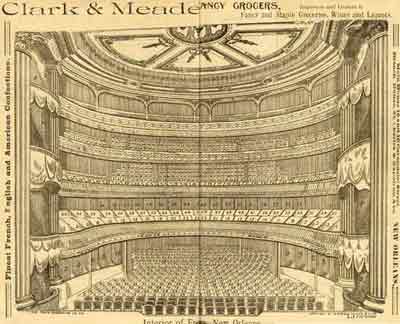
The seating plan for the French Opera House (Théâtre
d'Opéra)
"In 1873 the rights
and titles of the original company were acquired by L. Placide Canonge for
$40,000, and Canonge, acting for a syndicate, resold to the Merchants' Insurance
Co., mortgage creditor. Canonge himself assumed the
management, which he retained till 1878."
L. Placide Canonge
was a confidante of Mrs. Morphy. According to Regina Morphy-Voitier, "She also
composed the music
for a five act opera entitled Louise de Lorraine, the words of which were
written by L. Placide Canonge, one of the most
brilliant men of New-Orleans, a journalist of talent, editor of L'Abeille de la
Nouvelle-Orleans, and also at one time
Impressario of the Theatre de l'Opera."
The Théâtre d'Opéra opened on
December 1, 1859
The opera
house was one of the most famous masterpieces designed by noted architect James
Gallier, architect of Gallier
Hall and many other classic 18th Century buildings. The great elliptical
auditorium was beautifully arranged with a color
scheme of red and white, and seated 1,800 persons in four tiers of seats. It was
Greek Revival in design, and its colonnaded
front measured 166 feet on bourbon Street and 187 feet on Toulouse Street. Its
80 foot high loft towered above all of the
buildings of the French Quarter. In the loges of the opera house, there were
screened boxes for pregnant ladies, ladies in
mourning, and "ladies-of-the-evening" (elegantly dressed madams from nearby
Storyville).
[see:
the History of The Inn on Bourbon
(built on the site of the Théâtre d'Opéra)]
and burned down on
December 4, 1919. |

